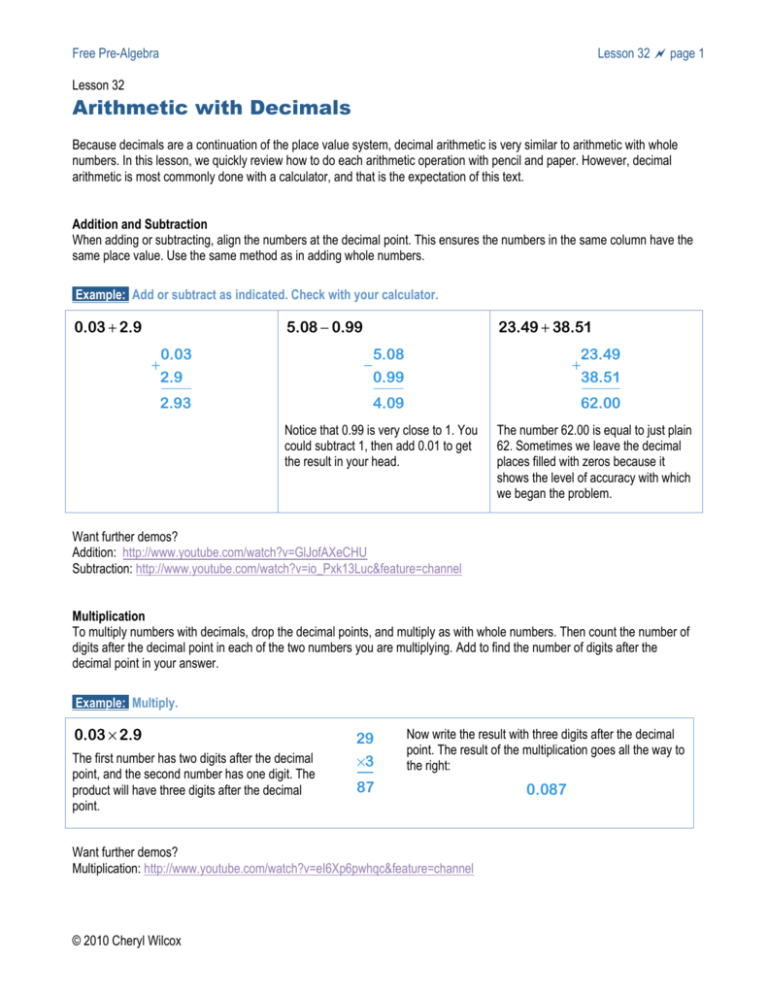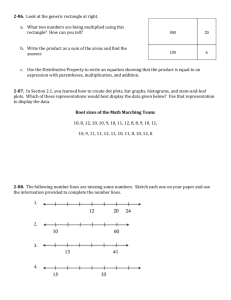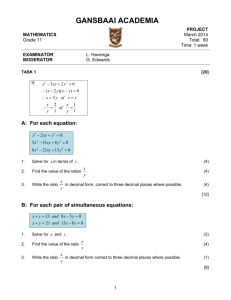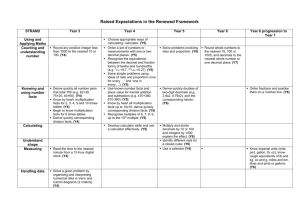Lesson 32 Text
advertisement

Free Pre-Algebra Lesson 32 ! page 1 Lesson 32 Arithmetic with Decimals Because decimals are a continuation of the place value system, decimal arithmetic is very similar to arithmetic with whole numbers. In this lesson, we quickly review how to do each arithmetic operation with pencil and paper. However, decimal arithmetic is most commonly done with a calculator, and that is the expectation of this text. Addition and Subtraction When adding or subtracting, align the numbers at the decimal point. This ensures the numbers in the same column have the same place value. Use the same method as in adding whole numbers. Example: Add or subtract as indicated. Check with your calculator. 0.03 + 2.9 5.08 ! 0.99 + 0.03 2.9 23.49 + 38.51 ! 2.93 5.08 0.99 + 4.09 23.49 38.51 62.00 Notice that 0.99 is very close to 1. You could subtract 1, then add 0.01 to get the result in your head. The number 62.00 is equal to just plain 62. Sometimes we leave the decimal places filled with zeros because it shows the level of accuracy with which we began the problem. Want further demos? Addition: http://www.youtube.com/watch?v=GlJofAXeCHU Subtraction: http://www.youtube.com/watch?v=io_Pxk13Luc&feature=channel Multiplication To multiply numbers with decimals, drop the decimal points, and multiply as with whole numbers. Then count the number of digits after the decimal point in each of the two numbers you are multiplying. Add to find the number of digits after the decimal point in your answer. Example: Multiply. 0.03 ! 2.9 The first number has two digits after the decimal point, and the second number has one digit. The product will have three digits after the decimal point. 29 !3 Now write the result with three digits after the decimal point. The result of the multiplication goes all the way to the right: 87 0.087 Want further demos? Multiplication: http://www.youtube.com/watch?v=eI6Xp6pwhqc&feature=channel © 2010 Cheryl Wilcox Free Pre-Algebra Lesson 32 ! page 2 Division Moving the decimal point in the divisor allows us to locate it easily in the quotient. Example: Divide. 0.85 ÷ 0.3 Start by writing a long division: 0.3 0.85 Change the number outside the division symbol to a whole number. We change 0.3 to 3 by moving the decimal point one place right. We match the movement of the decimal point in the other number, so 0.85 becomes 8.5. Now use long or short division. The decimal point of the answer is immediately above the decimal point of the number inside the division symbol. You can add zeros to the end of the number inside the division symbol until the decimal terminates or the repeating pattern becomes clear. 2.833 3 8.500 6 2.5 2.4 0.10 0.09 0.010 ?.??? 3 8.500 0.009 3. 8.5 Video Demo of Divison: http://www.youtube.com/watch?v=UiB1pB_5leU Exponents To evaluate expressions with exponents, convert to multiplication. Example: Evaluate. (0.4 ) (1.4 ) 2 2 ( )( ) = 0.4 0.4 = 0.16 (0.5) = ( 0.5) ( 0.5) ( 0.5) = 0.125 3 ( )( ) = 1.4 1.4 = 1.96 Compare to 42 = 16. Compare to 142 = 196. Compare to 53 = 125 (0.04 ) = ( 0.04 ) ( 0.04 ) = 0.0016 (1.04 ) = (1.04 ) (1.04 ) = 1.0816 (0.005) = ( 0.005) ( 0.005) ( 0.005) 2 2 Compare to 1042 = 10,816 © 2010 Cheryl Wilcox 3 = 0.000000125 Free Pre-Algebra Lesson 32 ! page 3 Using a Calculator Effectively At this point in the course, you should already own a scientific calculator. If not, rush right out and get one immediately. Simple calculators do operations in the order they are entered, and do not have a key for exponents. The main reason to use a scientific rather than a simple four-function calculator is that scientific (and graphing) calculators use the correct order of operations in evaluating long expressions. Four-Function Calculator Scientific Calculator Graphing Calculator Mainly for doing simple budgeting and checkbook calculations. Forever useful in all math and science courses. Commonly used in precalculus and calculus courses. Necessary for statistics. Approximately $2 – $10. Approximately $10 – $20. Approximately $100 – $140. Order of Operations These problems are good practice in being adept with your calculator. Try to type in the expression in the order written, including parentheses, and wait until the end to press enter. You will need to experiment with your calculator to see if you need to press the multiply key between a number and parentheses, as in the example. Example: Evaluate each expression. ( ) 0.7 0.4 + 7.88 With calculator: ( 0.7 0.4 + 7.88 ) With pencil and paper: ( = 0.7 ( 8.28) 0.7 0.4 + 7.88 = 5.796 Notice that you don’t need the zero in the ones place when entering decimals on the calculator. The calculator will put it in for you. © 2010 Cheryl Wilcox ) Free Pre-Algebra Lesson 32 ! page 4 Evaluating Algebraic Expressions It will be a relief to finally be able to use decimals in formulas. Example: Use a formula to solve the problem. Convert 75.2ºF to Celsius, using the formula C = . F ! 32 1.8 (75.2) ! 32 = 24ºC Find the perimeter and area of a rectangle with length 4.2 cm and width 9.5 cm. Perimeter: ( ) ( ) )( ) P = 2 4.2 cm + 2 9.5 cm = 27.4 cm 1.8 Keystrokes: ( 2 Area: A = 4.2 cm 9.5 cm = 39.9 cm A boat traveled at 22.5 mph for 7.5 hours. What distance did it travel? ( )( ) d = 22.5 7.5 = 168.75 miles The height (in feet) of an orange t seconds after tossing it up is given by the equation h = !16t 2 + 10t + 6 . Find the height after 0.9 seconds. ( ) 2 ( ) h = !16 0.9 + 10 0.9 + 6 = 2.04 ft Rounding Decimals This is another situation where our experience with whole numbers is valuable. Rounding a decimal number to a given place value or a given number of decimal places is very similar to rounding whole numbers. Example: Round the numbers as instructed. Round 6.7291 to the nearest tenth. Round 6.7291 to the nearest hundredth. Find the tenths place: 6.7291 Find the hundredths place: 6.7291 The next digit is the trigger: 6.7291 Since the trigger is less than 5, we do not round up. The next digit is the trigger: 6.7291 Since the trigger is greater than 5, we round up. 6.7 The tenths place is now the smallest place value. © 2010 Cheryl Wilcox 6.73 The hundredths place is now the smallest place value. Free Pre-Algebra Lesson 32 ! page 5 Example: Round the numbers as instructed. Round 7.3 to the nearest thousandth. Round 0.54 to the nearest ten-thousandth. Write out enough of the repeating digits to get past the thousandths place: 0.54545454… 7.333333… Locate the thousandths place and the trigger. 0.54545 7.3333 Round as usual. The trigger is less than 5. 0.5455 7.333 Example: Round the numbers as instructed. Round 3.1412 to two decimal places. Round 2.186 to three decimal places. This means there should be two digits after the decimal point in your rounded answer. The third digit is the trigger. 3.1412 2.186666 3.14 2.187 Example: Solve using a formula. Round answers as indicated. A box has sides 5.5 cm, 3.6 cm, and 4.1 cm. Find the volume of the box. Round to the nearest tenth. Convert –38.5ºC to Fahrenheit, using the formula F = 1.8C + 32 . Round to the nearest whole degree. ( )( )( ) ( ) V = 5.5 3.6 4.1 = 81.18 F = 1.8 !38.5 + 32 = –37.3 The volume is approximately 81.2 cm3 –38.5ºC is approximately –37ºF ! © 2010 Cheryl Wilcox Free Pre-Algebra Lesson 32 ! page 6 Lesson 32: Arithmetic with Decimals Worksheet Name ______________________________________________ Do the decimal arithmetic with pen and pencil. Check with your calculator. Then convert the numbers to fractions or mixed numbers and redo the arithmetic with fractions. Compare your results. 1. Add 0.45 + 2.1 Convert the numbers in the previous problem to fractions and add. 2. Subtract 8.09 ! 6.5 Convert the numbers in the previous problem to fractions and subtract. ( )( ) 3. Multiply 7.1 0.7 Convert the numbers in the previous problem to fractions and multiply. 4. Divide 1.1÷ 0.3 Convert the numbers in the previous problem to fractions and divide. 5. $1,000,000 was split between 33 winners. How much did each winner receive? Round to the nearest penny. A rectangle has length 0.03 cm and width 0.205 cm. Find the area and perimeter. Round to the nearest thousandth. Area: Perimeter: © 2010 Cheryl Wilcox Free Pre-Algebra Lesson 32 ! page 7 Lesson 32: Arithmetic with Decimals Homework 32A Name _________________________________________ 1. Addition. !3 + !8 0.3 + 0.8 0.03 + 0.08 3 8 + 10 10 Write a word problem to go with one of the above arithmetic problems. 2. Subtraction. 2!7 0.2 ! 0.7 0.02 ! 0.07 2 7 ! 10 10 Write a word problem to go with one of the above arithmetic problems. 3. Multiplication. (14 )(9) (1.4 )(0.9) ! 4 $! 9 $ #" 110 &% #" 10 &% (1.4 )(9) Write a word problem to go with one of the above arithmetic problems. 4. Division. 74 / 3 7.4 / 0.3 74 3 ÷ 10 10 Write a word problem to go with one of the above arithmetic problems. © 2010 Cheryl Wilcox 7.4 / 3 Free Pre-Algebra Lesson 32 ! page 8 5. Compare the perimeters. 6. Compare the areas. a. Find the perimeter of a rectangle with length 15 cm and width 24 cm. a. Find the area of a rectangle with length 15 cm and width 24 cm. b. Find the perimeter of a rectangle with length 1.5 cm and width 2.4 cm. b. Find the area of a rectangle with length 1.5 cm and width 2.4 cm. c. How many times would an ant have to walk around the small rectangle to go the same distance as an ant who walked once around the large rectangle? c. How many copies of the small rectangle will fit inside the large rectangle? 7. Compare the volumes. Find the volume of a box with sides 20 cm, 30 cm, and 40 cm. Find the volume of a box with sides 0.2 cm, 0.3 cm, and 0.4 cm. How many of the small boxes will fit into the big box? 8. Conversions. How many inches is 23 cm? (1 inch = 2.54 cm) How many cm is 23 inches? (1 inch = 2.54 cm) Round to the nearest tenth. Round to the nearest tenth. © 2010 Cheryl Wilcox Free Pre-Algebra Lesson 32 ! page 9 Lesson 32: Arithmetic with Decimals Homework 32A Answers 1. Addition !3 + !8 = !11 0.3 + 0.8 = 1.1 0.03 + 0.08 = 0.11 3 8 11 + = 10 10 10 Write a word problem to go with one of the above arithmetic problems. Sample: The tax on one item was $0.03 and on the other item was $0.08. What was the total amount of tax? 2. Subtraction 2 ! 7 = !5 0.2 ! 0.7 = !0.5 0.02 ! 0.07 = !0.05 2 7 5 1 ! =! =! 10 10 10 2 Write a word problem to go with one of the above arithmetic problems. Sample: I have to pay my friend $7 and I have only $2. How much do I owe? 3. Multiplication (14 )(9) (1.4 )(0.9) = 1.26 = 126 ! 4 $ ! 9 $ 126 63 #" 110 &% #" 10 &% = 100 = 50 (1.4 )(9) = 12.6 Write a word problem to go with one of the above arithmetic problems. Sample: A rectangle has sides 1.4 cm and 0.9 cm. What is the area? 4. Division 74 / 3 = 24.6 = 24 2 3 7.4 / 0.3 = 24.6 74 3 2 ÷ = 24 10 10 3 Write a word problem to go with one of the above arithmetic problems. Sample: How many 0.3 cm slices can be cut from a 7.4 cm loaf? © 2010 Cheryl Wilcox 7.4 / 3 = 2.46 Free Pre-Algebra Lesson 32 ! page 10 5. Compare the perimeters. 6. Compare the areas. a. Find the perimeter of a rectangle with length 15 cm and width 24 cm. a. Find the area of a rectangle with length 15 cm and width 24 cm. ( ) ( )( ) P = 2 15 + 24 = 78 cm A = 15 24 = 360 cm2 b. Find the perimeter of a rectangle with length 1.5 cm and width 2.4 cm. ( b. Find the area of a rectangle with length 1.5 cm and width 2.4 cm. ) ( )( ) P = 2 1.5 + 2.4 = 7.8 cm A = 1.5 2.4 = 3.60 cm2 c. How many times would an ant have to walk around the small rectangle to go the same distance as an ant who walked once around the large rectangle? 78 / 7.8 = 10 Ten times around the small rectangle equals once around the large rectangle. c. How many copies of the small rectangle will fit inside the large rectangle? 360 / 3.6 = 100 One hundred copies of the small rectangle fit inside the large rectangle. 7. Compare the volumes. Find the volume of a box with sides 20 cm, 30 cm, and 40 cm. Find the volume of a box with sides 0.2 cm, 0.3 cm, and 0.4 cm. ( )( )( ) ( )( )( ) V = 20 30 40 V = 0.2 0.3 0.4 = 24000 cm3 = 0.024 cm3 How many of the small boxes will fit into the big box? 24,000 / 0.024 = 1,000,000 One million small boxes will fit inside the large box. 8. Conversions How many inches is 23 cm? (1 inch = 2.54 cm) How many cm is 23 inches? (1 inch = 2.54 cm) Round to the nearest tenth. Round to the nearest tenth. 23 cm 1 in • = 23 / 2.54 in 1 2.54 cm 23 in 2.54 cm • = 58.42 cm 1 1 in ! 9.1 inches ! 58.4 cm © 2010 Cheryl Wilcox Free Pre-Algebra Lesson 32 ! page 11 Lesson 32: Arithmetic with Decimals Homework 32B Name _________________________________________ 1. Addition !4 + 9 !0.4 + 0.9 !4 + 90 !0.04 + 0.9 Write a word problem to go with one of the above arithmetic problems. 2. Subtraction 12 ! 8 1.2 ! 0.8 0.12 ! 0.08 0.12 ! 0.8 Write a word problem to go with one of the above arithmetic problems. 3. Multiplication ( 4 )( !22) (0.4 )( !22) (0.4 )( !2.2) (0.4 )( !0.22) Write a word problem to go with one of the above arithmetic problems. 4. Division 48 ÷ 4.5 4.8 ÷ 4.5 48 ÷ 0.45 Write a word problem to go with one of the above arithmetic problems. © 2010 Cheryl Wilcox 480 ÷ 45 Free Pre-Algebra Lesson 32 ! page 12 5. Compare the perimeters. 6. Compare the areas. a. Find the perimeter of a rectangle with length 40 cm and width 50 cm. a. Find the area of a rectangle with length 40 cm and width 50 cm. b. Find the perimeter of a rectangle with length 0.4 cm and width 0.5 cm. b. Find the area of a rectangle with length 0.4 cm and width 0.5 cm. c. How many times would an ant have to walk around the small rectangle to go the same distance as an ant who walked once around the large rectangle? c. How many copies of the small rectangle will fit inside the large rectangle? 7. Compare the volumes. Find the volume of a box with sides 4 cm, 5 cm, and 6 cm. Find the volume of a box with sides 0.4 cm, 0.5 cm, and 0.6 cm. How many of the small boxes will fit into the big box? 8. Conversions How many inches is 95 cm? (1 inch = 2.54 cm) How many cm is 95 inches? (1 inch = 2.54 cm) Round to the nearest tenth. Round to the nearest tenth. © 2010 Cheryl Wilcox








